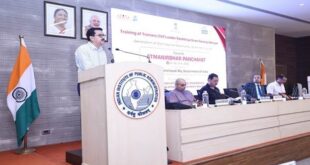- China’s National Health Commission (NHC) announced that a four-year-old boy was found to have been infected with the H3N8 variant of Bird Flu after developing several symptoms, including fever.
- H3N8 variant has previously been detected elsewhere in the world in horses, dogs, birds and seals.
- However, before this no human cases of H3N8 have been reported.
- Avian influenza—known informally as avian flu or bird flu—refers to “influenza caused by viruses adapted to birds”.
- Most avian influenza viruses do not infect humans, however, some, such as A(H5N1) and A(H7N9), have caused serious infections in people.
- There is no vaccine against H5N1.
- Most avian influenza viruses do not infect humans, however some, such as A(H5N1) and A(H7N9), cross the species barrier and cause disease or subclinical infections in humans and other mammals as well.
- The Avian (H5N1) virus subtype, a highly pathogenic virus, first infected humans in 1997 during a poultry epidemic outbreak in Hong Kong SAR, China.
Types of Influenza Virus
- There are four types of influenza viruses: influenza A, B, C, and D.
- Influenza A and B are the two types of influenza that cause epidemic seasonal infections nearly every year.
- Avian influenza Type A viruses
- Type A viruses are classified based on two proteins on their surfaces – Hemagglutinin (HA) and Neuraminidase (NA).
- There are about 18 HA subtypes and 11 NA subtypes.
- Several combinations of these two proteins are possible e.g., H5N1, H7N2, H9N6, H17N10, H18N11 etc.
- Influenza C mainly occurs in humans, but has been known to also occur in dogs and pigs.
- Influenza D is found mainly in cattle. It’s not known to infect or cause illness in humans yet.
A Cause Of Concern
- Speculation about the origin of the SARS-CoV-2 has heightened worries about animal- and bird-borne viruses.
- The emergence of new strains, particularly among domesticated animals and birds, is a story of evolution and inevitability, and sporadic reports of new viruses infecting humans abound.
- As long as avian influenza viruses circulate in poultry, sporadic infection of avian influenza in humans is not surprising, which is a vivid reminder that the threat of influenza pandemic is persistent
- Several subtypes and strains of avian influenza viruses are now found around the world, some of them capable of causing death among humans and others inflicting serious losses on poultry farmers.
- Though Human to Human transmission — which takes place mostly after intimate and constant physical contact — is rare, the infection is virulent and, in an estimated 60% of cases, fatal.
- There are no known instances of the flu spreading through ingestion of the bird, even though people do contract it while plucking or culling an infected bird without proper protection, or if they are in a water body that has the droppings of an infected bird.
- In humans, the symptoms of bird infection are the same as that of any other seasonal flu — fever, body ache, sore throat, runny nose, headache, fatigue, etc., however, it can turn serious very quickly, and lead to respiratory distress.
- It incorporates a clear protocol for preventive checks and testing, for reporting an outbreak, removing farm birds from an affected area and compensating farmers.
- It relies on a broad-based periodic testing system for farm birds and wet markets, and upgrading of apex scientific institutions such as the National Institute of High Security Animal Diseases, Bhopal.
- The early detection and identification of the virus subtypes helps in launching containment measures.
- Public health messaging, with advice on poultry consumption during a suspected outbreak, is essential to contain the outbreak as well as curtailing rumor mongering.
- The efficacy of the measures naturally depends on the alacrity with which the animal husbandry apparatus at the State level collects samples and sounds the alarm when a disease outbreak is imminent.
SOURCE: THE HINDU,THE ECONOMIC TIMES,MINT
 Chinmaya IAS Academy – Current Affairs Chinmaya IAS Academy – Current Affairs
Chinmaya IAS Academy – Current Affairs Chinmaya IAS Academy – Current Affairs



